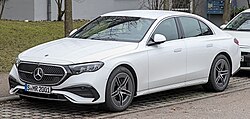6th generation (2023-present)
8th generation (2024-present)
5th generation (2018–present)
1st generation (2016-present)
The E-segment is the 5th category of the European segments for passenger cars, synonymous with the term executive car. [1] [2] [3]
Contents
- Characteristics
- European vs. American classification
- Current models
- Sales figures in Europe
- Market share in Europe
- See also
- Notes
- References
E-Segment is a niche in Europe (2-3% penetration in 2010s). In 2017, 2018, 2019 and 2020, E-segment sales accounted for 2.7%, 2.7%, 2.3% and 2.1% market share in Europe, respectively. [4] [5] [6] [7]












